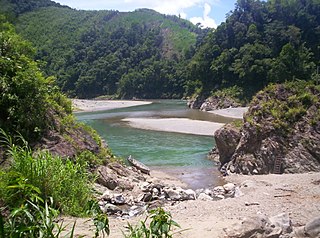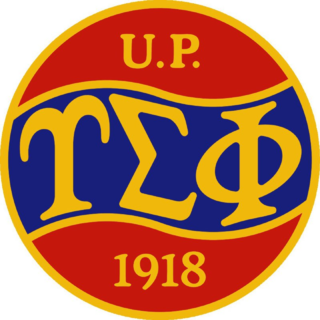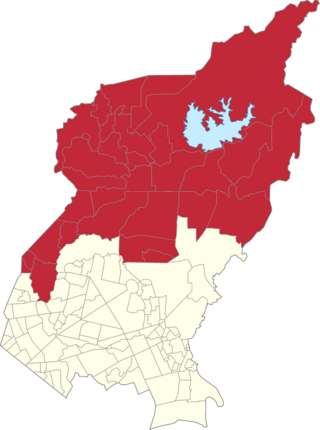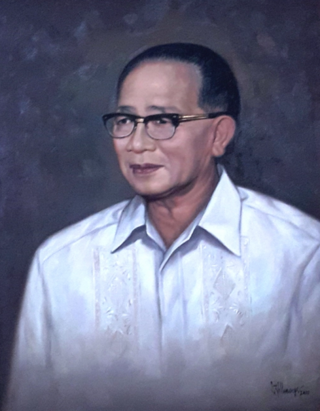
Metropolitan Manila, commonly shortened to Metro Manila and formally the National Capital Region, is the capital region and largest metropolitan area of the Philippines. Located on the eastern shore of Manila Bay, the region lies between the Central Luzon and Calabarzon regions. Encompassing an area of 636.00 km2 (245.56 sq mi) and with a population of 13,484,462 as of 2020, it is composed of sixteen highly urbanized cities: the capital city, Manila, Caloocan, Las Piñas, Makati, Malabon, Mandaluyong, Marikina, Muntinlupa, Navotas, Parañaque, Pasay, Pasig, Quezon City, San Juan, Taguig, and Valenzuela, along with one independent municipality, Pateros. As the second most populous and the most densely populated region in the Philippines, it ranks as the 9th most populous metropolitan area in Asia and the 6th most populous urban area in the world.

Manila, officially the City of Manila, is the capital and second-most populous city of the Philippines, after Quezon City. Located on the eastern shore of Manila Bay on the island of Luzon, it is classified as a highly urbanized city. Manila is the world's most densely populated city proper, with 71,263 inhabitants per square kilometer (184,570/sq mi) and a population of 1,846,513 people in 2020; it is also the historic core of a built-up area that extends well beyond its administrative limits. Manila was the first chartered city in the country, designated by Philippine Commission Act No. 183 on July 31, 1901. It became autonomous with the passage of Republic Act No. 409, "The Revised Charter of the City of Manila", on June 18, 1949. Manila is considered to be part of the world's original set of global cities because its commercial networks were the first to extend across the Pacific Ocean and connect Asia with the Spanish Americas through the galleon trade. This marked the first time an uninterrupted chain of trade routes circling the planet had been established.

The University of the Philippines Diliman, also referred to as UP Diliman or simply University of the Philippines (UP), is a public, coeducational, research university located in Diliman, Quezon City, Philippines. It was established on February 12, 1949, as the flagship campus and seat of administration of the University of the Philippines System, the premier and national university of the Philippines.

Quezon City, also known as the City of Quezon and Q.C., is the most populous city in the Philippines. According to the 2020 census, it has a population of 2,960,048 people. It was founded on October 12, 1939, and was named after Manuel L. Quezon, the second president of the Philippines.

Rodriguez, officially the Municipality of Rodriguez and commonly known by its former name Montalban, is a 1st class urban municipality in the province of Rizal, Philippines. According to the 2020 census, it has a population of 443,954 people making it the most populous municipality in the country. Pending an affirmation through plebiscite, Republic Act No. 11812 repealed Batas Pambansa Blg. 275 and intend to formally revert to its original municipal name Montalban.

Pagsanjan, officially the Municipality of Pagsanjan, is a 3rd class municipality in the province of Laguna, Philippines. According to the 2020 census, it has a population of 44,327 people.

Camp General Emilio Aguinaldo (CGEA), also known as Camp Aguinaldo, is the site of the general headquarters (GHQ) of the Armed Forces of the Philippines (AFP).

Dingras, officially the Municipality of Dingras, is a 2nd class municipality in the province of Ilocos Norte, Philippines. According to the 2020 census, it has a population of 40,127 people distributed over 31 barangays.

Marcos, officially the Municipality of Marcos, is a 4th class municipality in the province of Ilocos Norte, Philippines. According to the 2020 census, it has a population of 18,010.

Kabugao, officially the Municipality of Kabugao, is a 1st class municipality and de jure capital of the province of Apayao, Philippines. According to the 2020 census, it has a population of 16,215 people.

Calbayog, officially the City of Calbayog, is a 1st class component city in the province of Samar, Philippines. According to the 2020 census, it has a population of 186,960 people.

The Upsilon Sigma Phi (ΥΣΦ) is the oldest Greek-letter organization and fraternity in Asia. Founded in 1918, it is also the oldest student organization in continuous existence in the University of the Philippines. It has two chapters—a single chapter for the UP Diliman and the UP Manila campuses, and another for the UP Los Baños. Membership remains exclusive to UP students, and is by invitation only.

The U.P.–Ayala Land TechnoHub is an information technology hub jointly developed by the University of the Philippines Diliman and property developer Ayala Land. It is located along Commonwealth Avenue in U.P. Campus, Quezon City, Metro Manila. and occupies 20 ha (0.20 km2) of the 37.5 ha (0.375 km2) U.P. North Science and Technology Park inside the U.P. Diliman campus.

Bagong Pag-asa, also known as the Magsaysay District, is an administrative division in eastern Metro Manila. It is an urban barangay of Quezon City with low-density housing and is known for its shopping malls, transport hubs and office buildings.

Krus na Ligas is a barangay in Diliman, Quezon City in the Philippines. It is located within the premises of the University of the Philippines Diliman. It has a population of 21,287 based on the census conducted in 2020.

Quezon City's 2nd congressional district is one of the six congressional districts of the Philippines in Quezon City. It has been represented in the House of Representatives of the Philippines since 1987. The district consists of the eastern barangays bordering Marikina, San Mateo and Rodriguez. From 1987 to 2013, it was the most populous district in the country, encompassing the northern part of Quezon City commonly called as Novaliches, until it was redistricted in time for the 2013 election. Just like its pre-2013 composition, it still includes the Batasang Pambansa, the seat of the House of Representatives. It is currently represented in the 19th Congress by Ralph Wendel Tulfo of the Partido Federal ng Pilipinas (PFP).

Philam, also known as Philam Homes, Philamlife Homes or Phil-Am, is an administrative division in eastern Metro Manila, the Philippines. It is an urban barangay located in the first legislative district of Quezon City, consisting entirely of the Philam private subdivision and gated community.
The University of the Philippines Diliman Police (UPDP) is the campus police of the Diliman campus of the University of the Philippines in Quezon City, Philippines.

Mariana, is an administrative division in eastern Metro Manila, the Philippines. It is an urban barangay in Quezon City in a middle class residential and commercial area known as New Manila, which includes Barangay Mariana and the adjacent barangays of Damayang Lagi, Horseshoe and Valencia.

Norberto Salandanan Amoranto was a Filipino politician who served as Mayor of Quezon City from 1954 to 1976.























